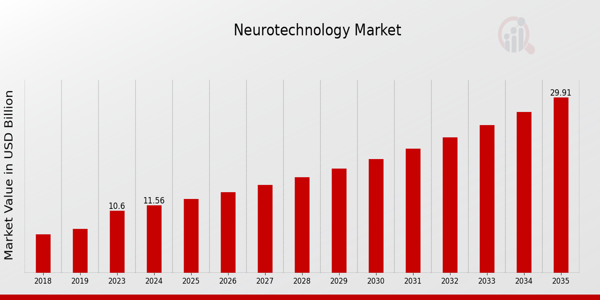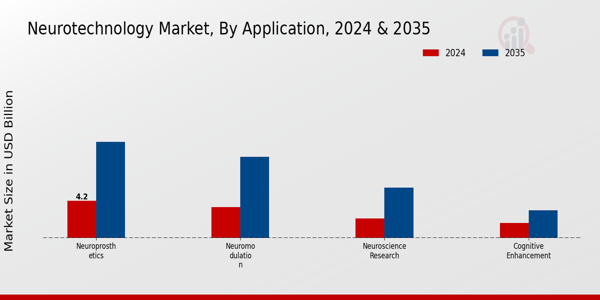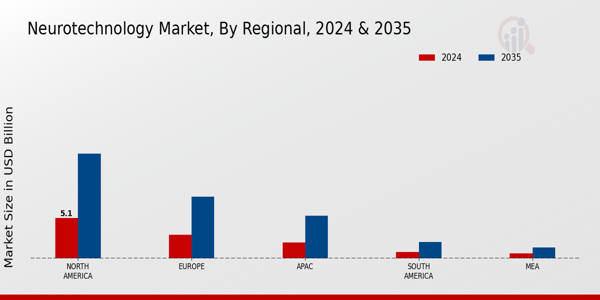Neurotechnology Market Overview
As per MRFR analysis, the Neurotechnology Market Size was estimated at 10.6 (USD Billion) in 2023.
The Neurotechnology Market Industry is expected to grow from 11.56(USD Billion) in 2024 to 29.9 (USD Billion) by 2035. The Neurotechnology Market CAGR (growth rate) is expected to be around 9.03% during the forecast period (2025 - 2035).
Key Neurotechnology Market Trends Highlighted
The global neurotechnology market is on an upward trajectory due to the advancement of brain-computer interfaces and neurostimulation techniques, as well as their increasing applications in the healthcare sector. Such drivers include a surge in cases of neurological disorders, a rapidly aging population, and the demand for further innovation in mental health treatment. The ability to apply artificial intelligence in neurotechnology fulfills the vital aspect of enhancing the functionality of the devices while facilitating the personalization of treatment modalities, which improves patient outcomes and widens the acceptance of neurotechnology in clinical practice. This dynamic shift provides a rich ground for exploration.
There are several areas that can be developed in this field, including the improvement of non-invasive neurotechnologies, which can be economically beneficial to healthcare systems simultaneously attracting a larger user base. Those include cognitive enhancement, rehabilitation therapies, and innovation in general. The expected collaboration between the tech industry and healthcare can lead to new products and services that address the existing gap in the market for neurological health. The latest developments suggest there is increased concern for mental health, including the use of nervos for treatment. Neurotechnology in the form of wearable devices that continuously monitor the brain and provide feedback is becoming popular among consumers and healthcare professionals.
Moreover, the possibility for using virtual and augmented reality technology integration into neurorehabilitation is getting clear, thus creating a branch market for these immersive therapeutic procedures. In the process of this market formation, issues such as legal regulation and ethical questions on data security and proxy consent will be of importance, raising the need for relevant frameworks that support confidence and ensure compliance with regulations by all the parties of interest.
Fig 1: Neurotechnology Market Overview

Source: Primary Research, Secondary Research, MRFR Database and Analyst Review
Neurotechnology Market Drivers
Rising Prevalence of Neurological Disorders
The Global Neurotechnology Market industry is experiencing significant growth driven primarily by the increasing prevalence of neurological disorders, including epilepsy, Alzheimer’s disease, and Parkinson’s disease. As the global population ages, the incidence of these disorders is expected to rise, leading to greater demand for neurotechnology solutions. Neurological conditions pose a substantial burden on healthcare systems, necessitating innovative approaches for diagnosis and treatment.
Advances in neurotechnology offer promising solutions, including brain-computer interfaces, neurostimulation devices, and neuroimaging technologies that improve patient outcomes and quality of life. The rising awareness of mental health issues has also highlighted the importance of neurotechnology in addressing these challenges, contributing to increased investment and research within the field. As healthcare providers seek effective ways to manage and treat these disorders, the demand for neurotechnology solutions is anticipated to grow, thus driving the overall market forward.
Furthermore, the integration of artificial intelligence and machine learning into neurotechnology applications is opening new avenues for personalized treatment options. Overall, the convergence of demographic trends and technological advancements makes the rising prevalence of neurological disorders a critical driver of growth in the Global Neurotechnology Market.
Technological Advancements
Advancements in technology play a significant role in propelling the Global Neurotechnology Market industry forward. Innovations in neuroimaging techniques, such as functional MRI and EEG, have improved the understanding and diagnosis of neurological conditions, leading to the development of more effective neurotechnology devices. Enhanced hardware and software solutions facilitate greater accuracy and efficiency in treatment methods, allowing for real-time monitoring and intervention.
As new technologies emerge, manufacturers are increasingly focused on creating smarter, more user-friendly devices that can cater to the diverse needs of patients. The integration of wearable technology and mobile applications is also expanding the accessibility of neurotechnology solutions, enabling users to track their conditions and treatments more effectively. Overall, continuous technological advancements are critical in enhancing the capabilities of neurotechnology devices and supporting better healthcare outcomes.
Increasing Investment in Research and Development
Investment in research and development is crucial for driving the Global Neurotechnology Market industry. With a growing recognition of the potential of neurotechnology, there has been an increase in funding from both the public and private sectors to advance research in this field. This funding supports the exploration of novel therapeutic approaches, and the development of innovative technologies aimed at addressing complex neurological disorders. As a result, this has spurred collaboration between academic institutions, research organizations, and industry players, fostering a thriving ecosystem for neurotechnology innovation.
The potential commercialization of groundbreaking research findings is also attracting investors and stakeholders who see opportunities in the burgeoning market. As investment continues to grow, it is expected to lead to a wave of new products and technologies that will further enhance the Global Neurotechnology Market.
Neurotechnology Market Segment Insights
Neurotechnology Market Application Insights
The Global Neurotechnology Market displayed robust growth within the Application segment, encompassing diverse areas such as Neuroprosthetics, Neuromodulation, Neuroscience Research, and Cognitive Enhancement. In 2024, this segment is set to reveal valuations that highlight its significance, with Neuroprosthetics valued at 4.2 USD Billion, positioning it as a major component within the market. Such devices, designed to restore or enhance functions lost due to neurological damage, dominate the landscape due to rising incidences of neurological disorders, driving substantial demand for innovative solutions in this area.
Neuromodulation follows closely, with a valuation of 3.5 USD Billion in 2024, representing a significant portion of the market aimed at altering nerve activity through targeted delivery of a stimulus, thereby showcasing its critical role in treating several conditions, including chronic pain and epilepsy. Neuroscience Research, valued at 2.2 USD Billion in 2024, plays an integral role as it offers insights into brain functions and mechanisms, essential for the development of new neurotechnologies, facilitating advances in treatments and therapies.
Lastly, Cognitive Enhancement, though smaller with a valuation of 1.66 USD Billion in 2024, serves a notable niche aimed at improving mental functions and highlighting the growing interest in enhancing cognitive abilities across various populations. This diverse segmentation paints a clear picture of market growth potential, where Neuroprosthetics appears to hold the majority share, driven by the urgent need for rehabilitative technologies, while Neuromodulation underlines significant clinical applications. As demand for effective therapies rises, these segments are expected to witness sustained growth, reflecting an increasing focus on both restoration and enhancement of cognitive and neurological functions among patients and consumers alike.
Global Neurotechnology Market revenue is likely to escalate, further substantiating trends towards advanced neurotechnological solutions for a myriad of clinical and research applications. The Global Neurotechnology Market segmentation presents a compelling narrative of a market that is evolving rapidly, with each application addressing pressing needs in healthcare and enhancement by leveraging innovative technologies. Thus, the statistics illustrate a dynamic landscape, with every sub-area holding its prominence and potential for notable market value increase in the years to come.
Fig 2: Neurotechnology Market Insights

Source: Primary Research, Secondary Research, MRFR Database and Analyst Review
Neurotechnology Market Technology Insights
The Global Neurotechnology Market is a rapidly growing sector within the technology landscape, forecasted to achieve a valuation of 11.56 billion USD by 2024. The market shows significant promise, with a projected value of 29.9 billion USD by 2035, reflecting the increasing integration of advanced technological solutions in healthcare. In the realm of neurotechnology, key areas such as Electroceuticals, Brain-Computer Interface, and Functional Electrical Stimulation play critical roles. Electroceuticals are gaining prominence due to their effectiveness in treating various neurological disorders, thus driving demand.
Brain-Computer Interfaces continue to transform communication methods for individuals with disabilities, showcasing their potential to enhance the quality of life. Functional Electrical Stimulation, on the other hand, offers rehabilitation possibilities for stroke patients, illustrating a vital application in neuromuscular therapies. The growth in these areas is fueled by technological innovations and a burgeoning need for effective neurological treatments, while the Global Neurotechnology Market segmentation highlights the diversity and extensive applications of neurotechnology, supported by robust Global Neurotechnology Market data and statistics driving overall market growth.
Neurotechnology Market End Use Insights
The Global Neurotechnology Market is poised for substantial growth across various end-use applications, highlighting a well-structured segmentation that caters to diverse needs. The healthcare sector stands out as a pivotal component, contributing significantly to the overall market revenue, driven by advancements in neurological treatments and diagnostic tools. Research institutions also play a crucial role, focusing on innovative developments that enhance our understanding of brain functions, which is essential for shaping future neurotechnological solutions.
The military and defense sector is emerging as a significant contributor due to the increasing adoption of brain-computer interfaces and neuro-enhancement technologies aimed at improving operational efficiency and soldier well-being. Furthermore, the commercial aspect of the neurotechnology industry is gaining traction, fostering the development of consumer-based products that harness neurotechnology for mental wellness and cognitive enhancement. Collectively, these sectors reveal significant opportunities and growth drivers within the Global Neurotechnology Market, underscoring a vibrant industry that caters to crucial societal needs and technological advancements.
As the market evolves, it is essential to consider the challenges faced by each segment, such as regulatory hurdles and ethical considerations, which could impact development timelines and market dynamics.
Neurotechnology Market Device Type Insights
The Global Neurotechnology Market is poised for significant growth, with projections showing a market value of 11.56 USD Billion in 2024. Within this landscape, the Device Type segment plays a crucial role, encapsulating key categories such as Wearable Tracking Devices, Implantable Devices, and Non-Invasive Devices. Wearable Devices are becoming increasingly popular due to their accessibility and ease of use, enabling real-time health tracking and monitoring. Implantable Devices are significant in treating chronic neurological disorders, providing advanced therapeutic solutions that can substantially improve patients' quality of life.
Non-Invasive Devices are pivotal as they allow for effective data collection without the need for surgery or alteration of body tissues, making it a preferred choice for both patients and healthcare providers. The growing prevalence of neurological diseases, rising healthcare expenditure, and increasing awareness around mental health are key drivers contributing to the Global Neurotechnology Market revenue. Moreover, advancements in technology and innovation present extensive opportunities for market participants, while regulatory challenges and high costs represent barriers that the industry must navigate.
Overall, the Global Neurotechnology Market statistics reflect a dynamic landscape, with Device Type emerging as a critical component for future developments in neurotechnology.
Neurotechnology Market Regional Insights
The Global Neurotechnology Market is projected to show significant growth, with regional segments expected to play a crucial role in shaping the industry landscape. North America holds a majority share, valued at 5.1 USD Billion in 2024 and expected to reach 13.2 USD Billion by 2035, driven by advanced healthcare infrastructure and substantial investments in research. Europe follows closely, with a valuation of 3.0 USD Billion in 2024 and an anticipated growth of 7.8 USD Billion, reflecting the region's strong focus on neurological research and development.
The APAC region, valued at 2.0 USD Billion in 2024 and projected to reach 5.4 USD Billion, is rapidly emerging due to rising healthcare expenditures and increasing awareness of neurotechnology solutions. South America and MEA, though smaller in value, stand at 0.8 USD Billion and 0.66 USD Billion in 2024, with growth potential driven by improving healthcare systems and rising neurological disorder prevalence. Each region's role contributes uniquely to the overall Global Neurotechnology Market, with North America dominating based on higher investment and technological advancements, while other regions present significant opportunities for market expansion and development.
Fig 3: Neurotechnology Market Regional Insights

Source: Primary Research, Secondary Research, MRFR Database and Analyst Review
Neurotechnology Market Key Players and Competitive Insights
The Global Neurotechnology Market has experienced significant growth in recent years, driven by advancements in technology and a rising awareness of neurological disorders. The market is characterized by a range of products and applications, including neuromodulation, neuroprosthetics, and brain-computer interfaces. Competition in this sector is intensifying as companies strive to innovate and develop novel solutions that cater to the increasing demand for effective treatments for neurological issues. Key players in the market are focusing on strategic partnerships, mergers, and acquisitions to enhance their product offerings and expand their market reach. Additionally, the increasing investment in research and development is facilitating the emergence of new technologies, thereby fostering a competitive landscape that continuously evolves.
Functional Neuromodulation is a prominent entity within the Global Neurotechnology Market, known for its strength in delivering tDCS-based interventions that demonstrate efficacy in treating chronic pain, depression, and stroke rehabilitation. The company's dedication to research and clinical applications showcases its competence in developing innovative neuromodulation techniques that align with patient needs. By leveraging advanced technology and clinical insights, Functional Neuromodulation has positioned itself as a leader in driving change within the neuromodulation market. Its strong focus on clinical validation and user-friendly devices further illustrates its commitment to making neurotechnology accessible and effective for a broader patient population, thereby solidifying its competitive edge in the industry.
Abbott Laboratories has made significant strides in the Global Neurotechnology Market, establishing itself as a key player with a comprehensive portfolio of neurostimulation technologies and devices tailored for diverse patient needs. The company emphasizes innovation in neurotechnology, investing heavily in research and clinical trials to enhance the effectiveness of its products. Abbott Laboratories is recognized for its advanced neuromodulation solutions, which are designed to alleviate neurological symptoms and improve patients' quality of life. The strategic emphasis on continuous improvement and user-centric product development empowers Abbott to compete effectively within the market. Their robust distribution channels and strong relationships with healthcare providers facilitate the accessibility of their offerings, enabling them to maintain a competitive position in the ever-evolving neurotechnology landscape.
Key Companies in the Neurotechnology Market Include
Neurotechnology Market Industry Developments
The Global Neurotechnology Market has seen significant recent developments, particularly in the area of innovative therapeutic solutions and advancements in neurostimulation technologies. Companies like Functional Neuromodulation and Abbott Laboratories have expanded their research on neuromodulation devices aimed at treating neurological disorders, emphasizing enhanced patient outcomes. NeuroPace's recent partnership with academic institutions focuses on advancing responsive neurostimulation for epilepsy, while Soterix Medical continues to innovate with non-invasive brain stimulation techniques aimed at various mental health conditions, showcasing the trend of non-invasive treatments gaining traction.
Additionally, Blackrock Neurotech has been involved in projects related to brain-computer interfaces, enhancing patient interaction with external devices. Enhanced valuations for companies like MindMaze and NeuroSky indicate robust investor interest, driven by the rise in neurological disease prevalence and an aging population. On the mergers and acquisitions front, notable activity includes Medtronic's strategic acquisition of technologies to broaden its neurostimulation portfolio, highlighting ongoing consolidation in the sector. Overall, the market is transforming with lucrative opportunities for companies focused on neurotechnology, driven by technological advancements and increasing focus on mental health management.
Neurotechnology Market Segmentation Insights
Neurotechnology Market Application Outlook
- Neuroprosthetics
- Neuromodulation
- Neuroscience Research
- Cognitive Enhancement
Neurotechnology Market Technology Outlook
- Electroceuticals
- Brain-Computer Interface
- Functional Electrical Stimulation
Neurotechnology Market End Use Outlook
- Healthcare
- Research Institutions
- Military and Defense
- Commercial
Neurotechnology Market Device Type Outlook
- Wearable Devices
- Implantable Devices
- Non-Invasive Devices
Neurotechnology Market Regional Outlook
- North America
- Europe
- South America
- Asia Pacific
- Middle East and Africa
|
Report Attribute/Metric
|
Details
|
|
Market Size 2023
|
10.6(USD Billion)
|
|
Market Size 2024
|
11.56(USD Billion)
|
|
Market Size 2035
|
29.9(USD Billion)
|
|
Compound Annual Growth Rate (CAGR)
|
9.03% (2025 - 2035)
|
|
Report Coverage
|
Revenue Forecast, Competitive Landscape, Growth Factors, and Trends
|
|
Base Year
|
2024
|
|
Market Forecast Period
|
2025 - 2035
|
|
Historical Data
|
2019 - 2024
|
|
Market Forecast Units
|
USD Billion
|
|
Key Companies Profiled
|
Functional Neuromodulation, Abbott Laboratories, NeuroPace, Soterix Medical, NeuroSky, MindMaze, Blackrock Neurotech, Neuroscience Technologies, Boston Scientific, Emotiv, CureMetrix, Nervive, Neuroelectrics, Medtronic, Synchron
|
|
Segments Covered
|
Application, Technology, End Use, Device Type, Regional
|
|
Key Market Opportunities
|
Advancements in brain-computer interfaces, Growing demand for mental health solutions, Increased investment in neurotechnology startups, Expansion of neuroprosthetics applications, Enhanced research in neurodegenerative diseases
|
|
Key Market Dynamics
|
Increasing demand for brain-computer interfaces, Growing prevalence of neurological disorders, Rising investment in neurotechnology research, Advancements in neuroimaging technologies, Expansion of wearable neurodevices
|
|
Countries Covered
|
North America, Europe, APAC, South America, MEA
|
Frequently Asked Questions (FAQ) :
The expected market size of the Global Neurotechnology Market in 2024 is valued at 11.56 USD Billion.
By 2035, the Global Neurotechnology Market is projected to reach a size of 29.9 USD Billion.
The expected CAGR for the Global Neurotechnology Market from 2025 to 2035 is 9.03%.
In 2024, the North America region holds the largest market value at 5.1 USD Billion.
The market value of the Neuroprosthetics application is expected to be 10.9 USD Billion in 2035.
The Neuromodulation application is expected to be valued at 3.5 USD Billion in 2024 and 9.2 USD Billion in 2035.
Key players in the Global Neurotechnology Market include Functional Neuromodulation, Abbott Laboratories, NeuroPace, and Medtronic.
The market size for Neuroscience Research application is valued at 2.2 USD Billion in 2024.
The APAC region is projected to have a market size of 5.4 USD Billion in 2035.
The Cognitive Enhancement application is currently valued at 1.66 USD Billion in 2024.

















